
* The Sparrow AAM, like the Sidewinder, became a mainstay of US fighter squadrons, was heavily exported, and saw extensive action. It was eventually replaced by the improved AMRAAM, which has become a standard as well, and continues to be refined.
* In 1947, the US Navy awarded a contract to Sperry Corporation to develop a guidance system for the standard 12.7-centimeter (5-inch) High-Velocity Air Rocket (HVAR), for use as an air-to-air missile. The weapon was originally designated "KAS-1", but that was soon changed to "AAM-2", and then "AAM-N-2". The HVAR airframe turned out to be too small, so Douglas developed a new airframe with a diameter of 20.3 centimeters (8 inches).
Initial unpowered test flights of "XAAM-N-2" prototypes began in 1948. Development proved troublesome, however, and the first successful intercept didn't take place until late 1952. The AAM-N-2 was finally introduced into service in 1956 as the "Sparrow I", being initially carried on F3H-2M Demon and F7U-3M Cutlass fighters.
The Sparrow I was tidy in appearance, having a dartlike nose; four gas-driven pivoting triangular wings in mid-body; four fixed triangular tailfins; and a solid-fuel rocket motor. The warhead was mounted behind the wings; the Sparrows had both impact and proximity fuzing. It used "beam-rider" guidance, with a radar receiver in the tail, following down the center of the launch aircraft's radar beam.
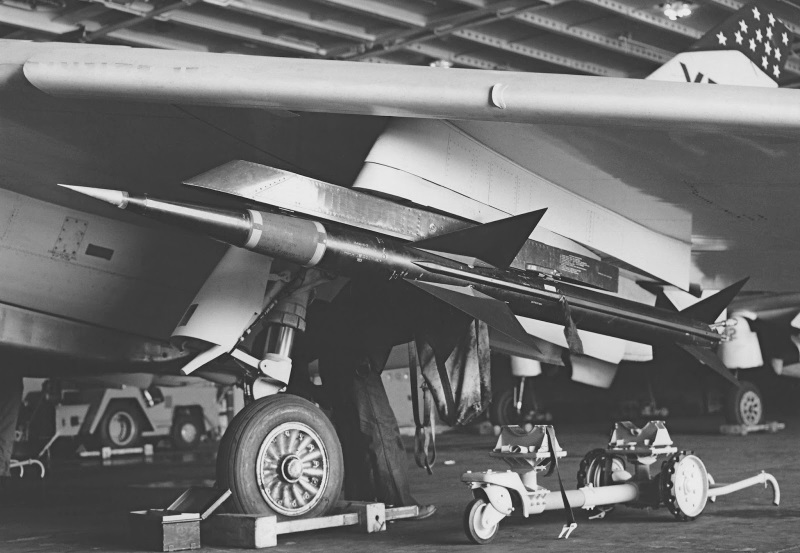
The first unpowered flight tests of XAAM-N-2 prototypes occurred in 1948. Development was difficult, however, and the first successful air-to-air interception was only done in December 1952. The AAM-N-2 Sparrow I entered service in 1956 on the McDonnell Demon and the Vought Cutlass.
The beam-riding scheme left something to be desired in terms of accuracy, and it didn't work well at low altitudes, being confounded by ground clutter. Another difficulty was that it had to be launched using an optical sight in the aircraft, meaning that it was limited to visual range. Only 2,000 Sparrow I missiles were built to end of production in 1956, and they were withdrawn from service after a few years.
___________________________________________________________________
AAM-N-2 SPARROW I:
___________________________________________________________________
wingspan:
94 centimeters (37 inches)
length:
3.74 meters (12 feet 3 inches)
diameter:
20 centimeters (8 inches)
total weight:
143 kilograms (315 pounds)
warhead weight:
20 kilograms (45 pounds)
speed:
Mach 2.5
range:
10 kilometers (6 MI / 5 NMI)
___________________________________________________________________
There were experiments on where to go next with the Sparrow, leading to work on the "AAM-N-3 Sparrow II". This version had an updated airframe, with a cylindrical forward fuselage and a tapered-cone nose, plus wider-span wings. The Sparrow II was to have an active-radar guidance system, meaning that it was to be "fire & forget" weapon -- once locked on target and launched, it would seek out the target on its own, without further supervision by the launch aircraft. It was to be carried by the Douglas F5D Skylancer and Avro Canada CF-105 interceptors -- neither of which entered service. Hardware for the AAM-N-3 was built and flown, but the missile proved too ambitious, with the US Navy pulling out of the program in 1956, dooming it.
BACK_TO_TOP* In the meantime, from 1955 Raytheon worked on the "AAM-N-6 Sparrow III", which used SARH guidance -- which was more accurate than beam-riding, but not as demanding as an active-radar seeker. The Sparrow III entered service in late 1958. It had the heftier airframe of the Sparrow II, though a shorter rear fuselage. About 2,000 were built, including some "TAAM-N-6" inert training rounds.
In the same timeframe, there was consideration of an "AAM-N-9 Sparrow X" with a low-yield nuclear warhead, but it never got out of the paper stage. The Sparrow III was followed in 1959 by the "AAM-N-6a Sparrow III", which had an improved seeker, featuring electronic counter-countermeasures. The US Air Force obtained it as the "AIM-101".
In 1962, the Pentagon adopted a common equipment designation system, with Sparrow designations being updated as follows:
Inert training versions of the AIM-7D were designated "ATM-7D". Of course, there was never really an AAM-N-3, so there was never an AIM-7B, that designation being included here only for completeness. In any case, the next version of the Sparrow was the "AIM-7E", originally known as "AAM-N-6b" before its introduction to service in 1963. It featured a solid-fuel rocket motor, which significantly increased range and performance. Several training variants were developed as well:
About 7,500 AIM-7D and 25,000 AIM-7E missiles were built. They were used heavily in the Vietnam War, mostly being carried by the McDonnell F-4 Phantom -- Phantoms in use with US Allies also generally carried the Sparrow. The first combat kill with a Sparrow was scored on 7 June 1965. There were reliability and pilot training issues involved -- a chicken-&-egg problem, it was hard to train pilots in the combat use of a weapon that hadn't been used in combat before -- but there was a more general problem, in that the early US AAMs had been more or less intended to shoot down bombers that could be assumed to be hostile even when out of the visual range of a pilot, and were generally not very maneuverable. In air combat over North Vietnam, it was hard to tell friend from foe, and North Vietnamese fighter aircraft tended towards the agile. Kill ratios of Sparrow firings were only about 10%, suggesting the kills were more lucky than not.
To fix these deficiencies, the "AIM-7E-2" was introduced in 1969. It was more reliable and had clipped wings for greater agility, as well as improved autopilot and fuzing. It also had a shorter minimum range, one of the other deficiencies of the original AIM-7E being that it couldn't be used on targets closer than 1,500 meters (5,000 feet). It was followed by the "AIM-7E-3", which was effectively the same, but corrected reliability issues. Despite all the problems, the Sparrow was credited with over 50 "kills" during the war.
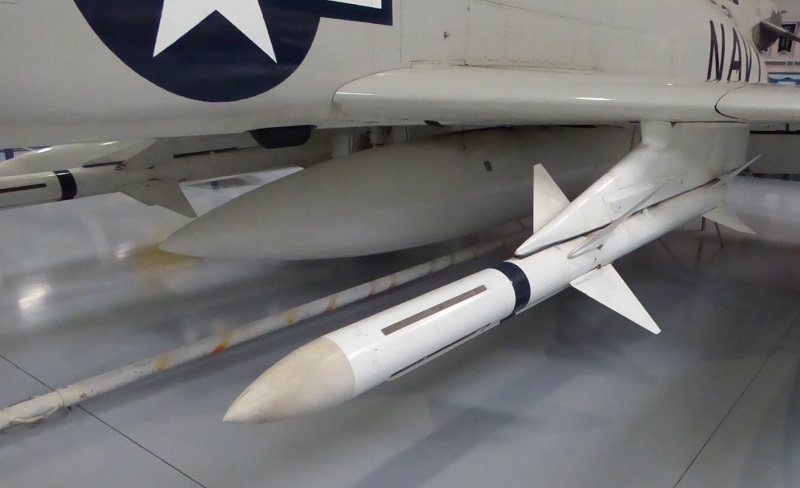
That variant was followed in turn the "AIM-7E-4", which had a seeker that could handle the very powerful AN/AWG-9 radar of the F-14. Apparently, the earlier seeker could be overloaded, or possibly even be fried, by a powerful radar return.
* The tough learning curve with the AIM-7E led to a rethinking of the Sparrow design, with the "AIM-7F" introduced in 1975; it was just called the "Sparrow", the "III" being dropped. It looked much like the AIM-7E, but featured:
The AIM-7F finally provided satisfactory reliability and lethality. Training variants were introduced, comparable to those of the AIM-7E: "ATM-7F", "CATM-7F", "DATM-7F", and "CAEM-7F".
There was work on an "AIM-7G", with an improved seeker, but it didn't go into production. That meant the AIM-7E was followed by the "AIM-7M", which entered service in 1982. Its primary change was a seeker system compatible with "monopulse" radars. Pulse radars originally derived target data such as speed and direction by comparing the returns of consecutive pulses. This simple scheme had the problem that the radar reflectivity of a target might change dramatically from one pulse to the next as the view of the aircraft changed, and the target would break radar lock. It was also fairly easy to spoof.
The solution was to send four overlapping pulses in parallel, each with a different polarization to allow them to be distinguished. That would permit the target to be tracked, even if its radar reflectivity changed abruptly. The AIM-4 had an "inverse monopulse" seeker, meaning that it was a receive-only system. The "M" in AIM-7M apparently meant "monopulse", which was why there was a skip in the designation sequence.
Since monopulse radars could handle surface clutter better than traditional pulse radars, the AIM-7M had improved "look-down / shoot-down" capability, allowing a launch aircraft at altitude to engage targets at low altitudes. It had a reprogrammable processor, an autopilot, and an improved warhead. The training versions were named "ATM-7M", "CATM-7M", "DATM-7M", and "CAEM-7M". In that era, the primary launch aircraft were the Grumman F-14 Tomcat, the McDonnell-Douglas F-15 Eagle, the McDonnell-Douglas F/A-18 Hornet, and the General Dynamics F-16 -- though early on, the F-16 wasn't Sparrow-compatible.
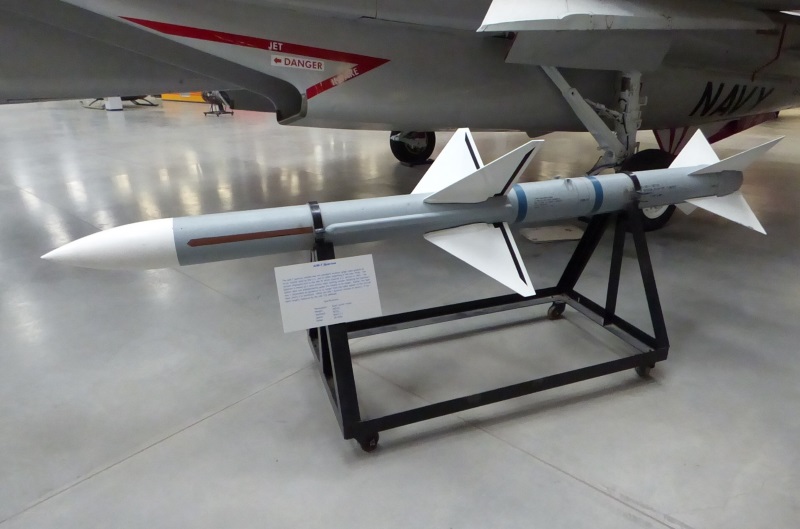
The "AIM-7N" was an upgraded AIM-7F, with not many turned out, and so the next significant Sparrow variant was the "AIM-7P" -- not different in general spec from the AIM-7M, but had generally updated avionics, with a more capable seeker, and an upload datalink to the autopilot to permit mid-course guidance updates. It was introduced in a "Block I" configuration, then later improved to a "Block II" configuration. Most AIM-7Ms were updated to AIM-7P spec. There was an "ATM-7P" training version of the AIM-7P, but for non-firing training, the older -7F/M training versions were used instead.
___________________________________________________________________
AIM-7M SPARROW:
___________________________________________________________________
wingspan:
81 centimeters (32 inches)
length:
3.7 meters (12 feet)
diameter:
20 centimeters (8 inches)
total weight:
230 kilograms (510 pounds)
warhead weight:
40 kilograms (88 pounds)
speed:
Mach 4
range:
70 kilometers (43 MI / 37 NMI)
___________________________________________________________________
In combat, the AIM-7M/P proved far superior to the Vietnam-era AIM-7D/E. During Operation Desert Storm, the Sparrow shot down 26 Iraqi aircraft out of 71 shots, a hit rate of almost 40%. That ratio actually seems low, but no doubt there were engagements at the edge of the missile's performance envelope, and possibly some use of defensive countermeasures by the Iraqis.
In the early 1990s, work was conducted on an even more advanced Sparrow variant, the "AIM-7R", the most prominent element in the new variant being a dual-mode SARH / infrared seeker. The AIM-7R was canceled in 1996 -- interest had moved on to the AIM-120 AMRAAM, more on that later.
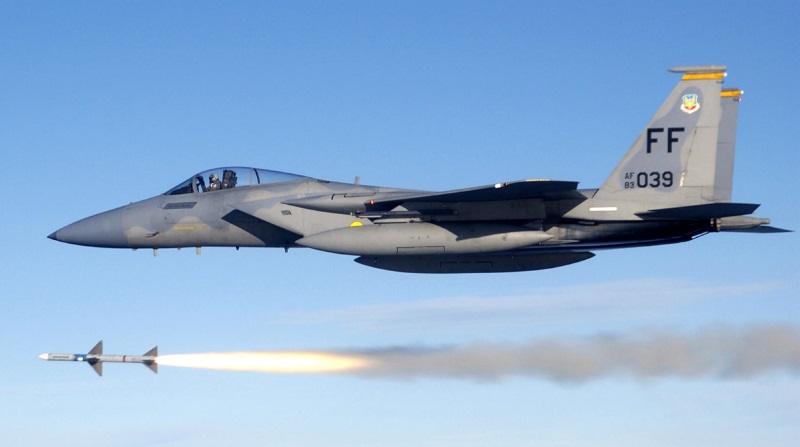
Over 69,000 Sparrows had been produced by Raytheon, and by Mitsubishi of Japan, up to end of new production, sometime around the turn of the century. At last notice, upgrades were still being performed to bring AIM-7Ms up to AIM-7P spec. While the US military has moved on to the AMRAAM, the AIM-7P still remains in extensive service with US allies; it's cheaper than AMRAAM, and still very effective.
* Two foreign nations, the UK and Italy, built their own variants of the Sparrow, both with inverse monopulse seekers. It appears that the British and Italians got frustrated with the limitations of the AIM-7E; the US eventually came out with the AIM-7M with an inverse monopulse seeker, but took too long to get there.
The UK derivative was the "Skyflash", developed by what is now British Aerospace. Along with the inverse monopulse seeker, it had general systems improvements. It was introduced to service in 1978, being carried on British Phantoms and the Tornado ADV interceptor. Skyflash was also built under license in Sweden as the "Rb 71", being carried on the SAAB Viggen and Gripen fighters.
The Italian derivative was the "Aspide (Adder)", developed by Selenia, which had built the Sparrow under license. Like the Skyflash, the Aspide added not only an inverse monopulse seeker, but also general system improvements. The resulting Aspide also was slightly different in appearance, with distinctive clipped wings. It was built in an air-launched version, with fixed wings, and in a surface-launched version, with folding wings so it could be launched from a canister.
Skyflash and Aspide are now both obsolete. The Aspide persists, however, since the Chinese obtained license rights to build it. Selenia cut itself loose from the license program in the wake of the 1989 Tianemen Square massacre, but the Chinese continued with the effort, introducing the "PL-11" during the 1990s, with export weapons designated "FD-60". While specifics of Chinese weapon systems tend toward the sketchy, the Chinese appear to have introduced improved versions:
The PL-11 remains in firstline service.
BACK_TO_TOP* The Sparrow proved adaptable to other roles. From early on, there was work on modifying it to serve as an "anti-radar/radiation missile", the weapon being originally designated simply "ARM", with the designation "ASM-N-10". The Navy began development of this weapon in 1958. It was put into production by a consortium of Texas Instruments and Sperry-Univac in 1963 as the "AGM-45A Shrike", after a small predatory songbird.
The Shrike looked much like a Sparrow, except that the wings and tailfins were no longer triangular; the wings had greater sweep and were clipped, while the tailfins were clipped trapezoids. Like the Sparrow, the Shrike was powered by a solid-fuel rocket motor. The early AGM-45A used a single-thrust motor, while the later AGM-45B, introduced in the early 1970s, used a boost-sustain motor that more than doubled the range. The missile was fitted with a blast-fragmentation warhead, with a proximity fuze. The operator boresighted the Shrike on an emitter and launched after the seeker reported a lock. The missile rode down the beam to the emitter and destroyed it.
___________________________________________________________________
AGM-45B SHRIKE:
___________________________________________________________________
wingspan:
0.91 meters (3 feet)
length:
3.05 meters (10 feet)
diameter:
20.3 centimeters (8 inches)
total weight:
177 kilograms (390 pounds)
warhead weight:
66 kilograms (145 pounds)
speed:
Mach 2
range at altitude:
40 kilometers (25 MI / 22 NMI)
___________________________________________________________________
The Shrike was introduced to combat in Southeast Asia in 1966, where it was carried by US Air Force F-105G Thunderchiefs and Navy EA-6A Intruders. Initial results were poor, and led to introduction of 13 different radar seeker heads, each optimized to attack different classes of target radars. Shrikes with different seeker heads were distinguished with a numeric suffix, with designations "AGM-45A-1" through "AGM-45A-10", and "AGM-45B-1" through "AGM-45B-10".
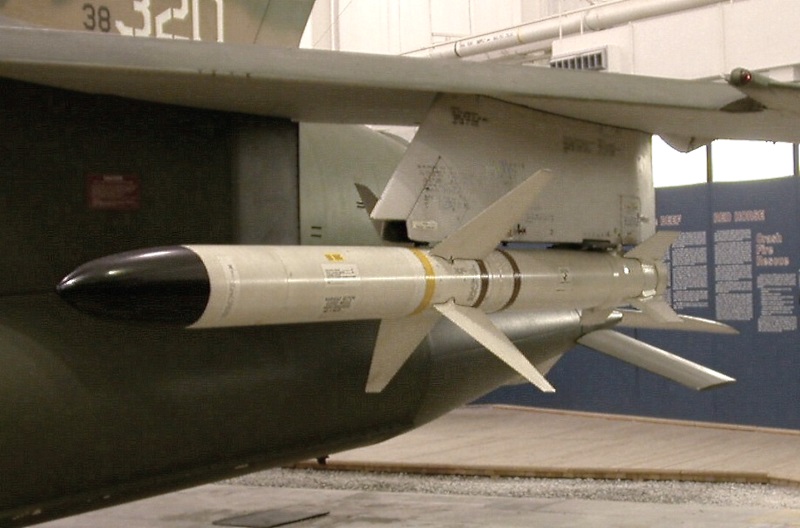
Eventually, the bugs were worked out. The Shrike became the standard anti-radiation missile for the USAF and US Navy, and was often used in defense suppression missions during the Vietnam War. The Israelis also used the Shrike, employing it in quantity during the 1973 Yom Kippur War. Unfortunately, no seeker head was available to deal with the new Soviet SA-6 antiaircraft missile system, and the Israelis suffered heavily from that weapon. The Israelis didn't find the Shrike very effective, though they went so far as to modify some of them for ground firing by adding launch boosters, and adapted Sherman tanks as launchers.
In addition, Shrikes provided by the US Navy were fitted to RAF Avro Vulcan bombers during the Falklands conflict in 1982. The Shrike was a somewhat comical fit of a little weapon to a big aircraft, but the Vulcans made good use of the American missiles, firing a total of four missiles in two strikes that shut down Argentine radar systems on the islands. About 18,500 Shrikes of all types were manufactured up to end of production in 1982. It saw its final use in the Gulf War, being finally phased out in 1992.
* The US Navy, after several years of casting about for a short-range surface-to-air missile (SAM) and coming up zeroes, decided to adopt the AIM-7E. The first test launches of the "RIM-7 Sea Sparrow" or "SeaSparrow" were in 1967, with the system phased into operational service from 1971,
The system was a straightforward, fast-track port of the air-launched weapon. It was fired from a Mark 25 launcher, modified from the ASROC (Anti-Submarine Rocket) launcher, with guidance from a Mark 115 continuous-wave radar illuminator. The Mark 115 illuminator looked like two searchlights flanking a rotating pedestal, under the control of a crewman cued to a target by voice instructions from shipboard radar operators, and spotting the target with an optical sight. With SARH, it wasn't necessary to get the illuminator precisely on target; as long as the target was within the radar beam, the missile would zero in on it.
The launcher was too big for smaller vessels like frigates, because the launch cells had to be sized to the Sparrow's wings. As a result, the RIM-7E was redesigned with folding wings as the "RIM-7H", with a new, more compact Mark 29 launcher introduced to launch the missile; the folding wings would be retained in later variants. The RIM-7H was introduced in 1973.
A new Mark 95 illuminator was introduced as well, similar to the earlier, clearly improvised Mark 115, but with automatic guidance -- the manual / optical guidance of course didn't work very well in darkness or bad weather. The launcher and the new illuminator were integrated with shipboard control and other sensors, including a low-light television imager, as the Mark 91 fire control system (FCS).
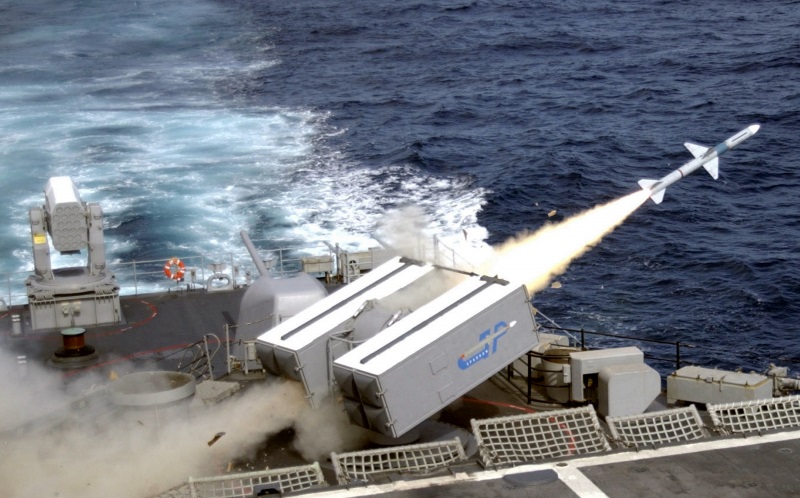
In 1968, the US signed an agreement with Denmark, Italy, and Norway to use the Sea Sparrow on their vessels as the "Improved Basic Point Defense Missile System (IBPDMS)", resulting in the formation of the "NATO Seasparrow Program Office (NSPO)". Eventually, the NSPO would add nine members, including Australia, Belgium, Canada, Germany, Greece, the Netherlands, Portugal, Spain, and Turkey. Japan would also acquire the Sea Sparrow, though it wasn't formally a member of the NSPO.
Incidentally, the Canadians fielded their own launcher system on the four destroyers of the IROQUOIS class, with an arm carrying four missiles extending from each side of the vessel, the arms normally being stowed in a "garage" in the superstructure. It was by all accounts a clumsy system, with a slow reaction time, difficult to reload, and unsuited to rough seas. As hinted earlier, the Italians would also field the Aspide as a naval SAM.
The RIM-7H was the initial export variant, being designated in that context as the "NATO Sea Sparrow Missile System (NSSM) Block 1." Denmark, Italy, and Norway adopted the Mark 91 FCS, while the Australians used an FCS developed by Bofors of Sweden, and the other eight users adopted the "Dutch" FCS, primarily developed by Hollandse Signaalapparaten. The RIM-7H was followed by improved variants, paralleling air-launched variants:
From the RIM-7M on, the Sea Sparrow could be fired from the Mark 41 and later Mark 57, or the Mark 48 Vertical Launch System (VLS) launchers. The primary difference between the Mark 41 / 57 is that the Mark 41 / 57 is a below-deck array, while the Mark 48 is a smaller above-deck array. Training versions of the RIM-7 were also built, being designated "RTM-7". Up to 2001, more than 62,000 AIM-7 Sparrow AAMs and 9,000 RIM-7 SAMs were produced.
Sea Sparrows were provided to Ukraine from 2023 to reinforce the Ukrainian shield against Russian air attacks. Soviet-era Buk-M1 tracked anti-aircraft missile launchers were modified to fire them; the inventories of the original Buk missiles were running low, but there were plenty of old Sea Sparrows available.
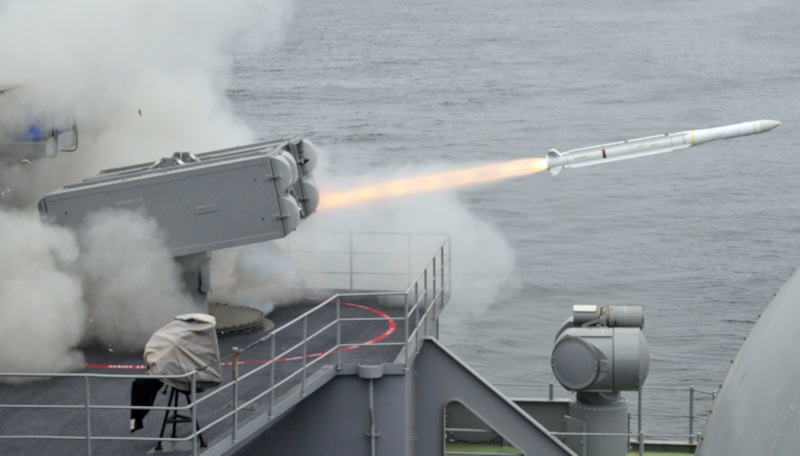
The Sea Sparrow, having originally been designed as an air-launched weapon, suffered from limited range, since it couldn't benefit from the speed and altitude of the launch aircraft. It was therefore heavily redesigned, to result in the "Evolved Sea Sparrow Missile (ESSM)", or "RIM-162".
___________________________________________________________________
RIM-162 EVOLVED SEA SPARROW MISSILE:
___________________________________________________________________
length:
3.7 meters (12 feet)
diameter:
25 centimeters (10 inches)
total weight:
280 kilograms (620 pounds)
warhead weight:
40 kilograms (88 pounds)
speed:
Mach 4
range:
> 50 kilometers (> 31 MI / 27 NMI)
___________________________________________________________________
The RIM-162, as it emerged, didn't have so much resemblance to an AIM-7; with its long strakelike wings and control tailfins, it somewhat resembled the bigger Navy Standard SAM. It was heftier than the AIM-7, notably with the diameter increased from 20 to 25 centimeters (8 to 10 inches), the larger rocket motor giving it better range. Most or all Sea Sparrow users updated to the ESSM; it was compatible with the existing Sea Sparrow FCS -- as well as the Aegis combat system of Aegis cruisers and destroyers. The RIM-162 remains in firstline service. It is possible that, over the longer run, Ukraine will obtain ESSMs for their updated Buk-M1 launchers.
BACK_TO_TOP* In the late 1970s, the US military began work on a successor to the Sparrow, a "beyond visual range AAM (BVRAAM)" that would have greater reach and an active radar seeker, giving it "fire & forget" capability. Hughes was given a development contract for the "AIM-120 Advanced Medium-Range AAA (AMRAAM)" in 1981. Development of the AIM-120 was difficult and protracted, with low-rate production not beginning until 1988, and introduction to operational service of the initial "AIM-120A" variant in 1991.
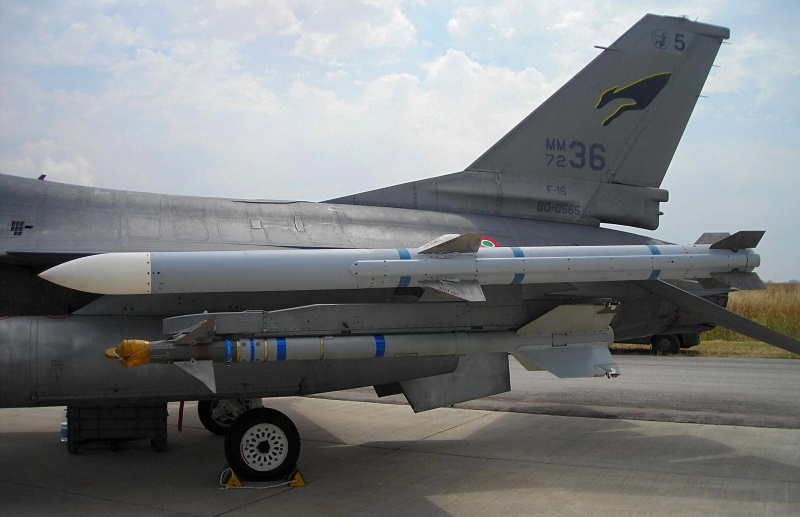
The AMRAAM, as introduced, had a general resemblance to the Sparrow; it looked longer than the Sparrow, but it was the same length, being lighter and slenderer. It didn't need to be as big, since its avionics were more compact, and it was more accurate, meaning it could get by with a smaller warhead -- featuring both impact and proximity fuzing. AMRAAM's wingspan wasn't as wide as that of the Sparrow, and the tailfins were the control surfaces, not the wings as with the Sparrow. It originally had a boost-sustain solid-rocket motor; later it went to a boost-only motor. Apparently, it turned out that maximizing acceleration and then gliding to the target after engine burn-out improved range.
___________________________________________________________________
AIM-120A AMRAAM:
___________________________________________________________________
wingspan:
53 centimeters (20.7 inches)
length:
3.7 meters (12 feet)
diameter:
18 centimeters (7 inches)
total weight:
152 kilograms (335 pounds)
warhead weight:
22.7 kilograms (50 pounds)
speed:
Mach 4
range:
> 55 kilometers (34 MI / 30 NMI)
___________________________________________________________________
Before firing, the launch aircraft programmed the AMRAAM's autopilot; guidance corrections could then be provided via datalink after launch. The missile activated its active radar seeker for terminal attack. The seeker also had a "home on jam (HOJ)" mode; if a target attempted to defend itself by noise jamming, the missile would then seek the jammer instead. The AIM-120 was complemented by the "CATM-120" captive-carry training missile; the "DATM-120A" for ground-handling training; and the "JAIM-120A", a telemetry module for test and evaluation purposes.
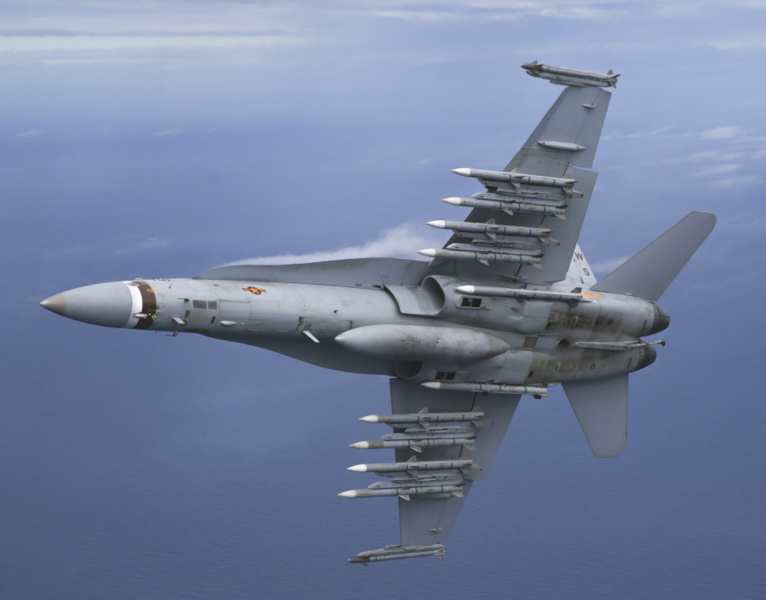
AMRAAM was fielded during the Gulf War from 1991, but there's no record of its use in that conflict. The first recorded use was on 27 December 1992, when a USAF F-16 shot down an Iraqi MiG-25 Foxbat interceptor, in the course of patrols over the Iraqi no-fly zone. This was also the first Air Force kill in an F-16.
The "AIM-120B" was introduced in 1994; it featured a new guidance system, with software in reprogrammable memory. It led to a "Pre-Planned Product Improvement (P3I)" program to evolve the weapon, resulting in the "AIM-120C" variant, introduced in 1996. The main feature of the AIM-120C was clipped wings and tailfins to permit carriage in the internal weapons bays of the F-22 Raptor, and later the F-35 JSF. Of course, it could be carried externally by any aircraft that could carry an AIM-120. The AIM-120C also had an improved guidance unit.
The baseline AIM-120C was followed by the "AIM-120C-4", "AIM-120C-5", "AIM-120C-6", and "AIM-120C-7". Tracing the evolution of these subvariants is confusing; enough to say that the end result, the AIM-120C-7, introduced to service in 2006, was generally a new missile. It featured a new guidance system, targeting seeker, warhead, fuzing system, and very significantly a new propulsion system. The AIM-120C-7 was smarter, more resistant to countermeasures, more lethal, and with range greater than 105 kilometers (65 miles / 57 NMI).
The AIM-120C-7 was followed by the "AIM-120D", originally the "AIM-120C-8", introduced in 2007. It featured an improved midcourse navigation system, a two-way datalink, better "high-angle off-boresight (HOBS)" capability, greater agility, and considerably extended range, greater than 160 kilometers (100 miles / 85 NMI). It obtained greater range by reducing the size of the avionics section, thanks to greater device integration and optimized circuit-board design, and increasing the side of the rocket motor. It has been followed by an "AIM-120D-3" subvariant -- it appears the "AIM-120D-2" wasn't fielded -- with further extended range, test launches being conducted from 2022. Apparently, part of the range enhancement was due to reducing the power consumption of the avionics, ensuring that the battery wouldn't be depleted at maximum range.
The AIM-120A and AIM-120B are now obsolescent, but the AIM-120C and AIM-120D missiles in service have received software updates under the System Improvement Program to keep them current. There have also been hardware updates, such as a new guidance system, that were flowed into production, and presumably retrofitted to existing inventory. Software and hardware continue to be refined.
Raytheon acquired the defense assets of Hughes in 1997, taking over the AMRAAM program. Over 14,000 AMRAAMs have been built to date, and the AIM-120 continues in production. The missile is carried by frontline US combat aircraft like the F-15, F-16, F/A-18, F-22, and F-35. It is also in service with the air arms of over 30 other nations. To date, about ten kills have been credited to AMRAAM -- though two of them were US Army Sikorsky Black Hawk helicopters, shot down over Iraq in 1994 during a ghastly "friendly fire" incident.
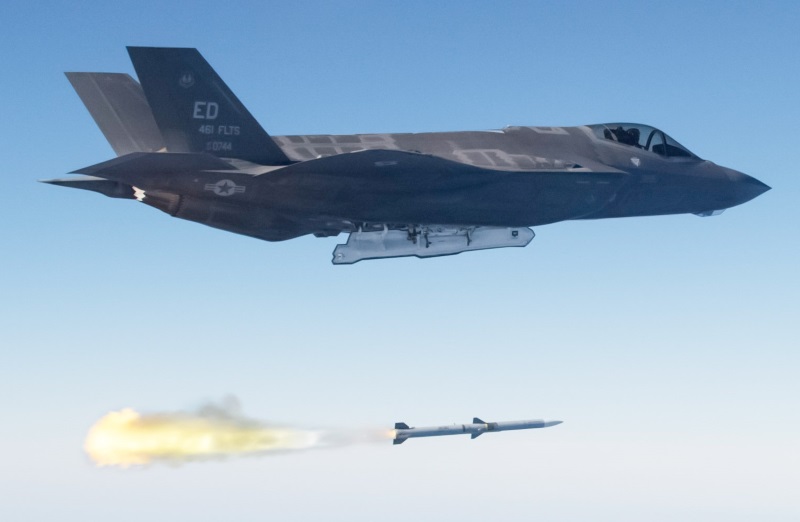
Raytheon test-flew a ramjet-powered AMRAAM, but it never entered production. The ramjet engine was supposed to grant it greater range, but it appears the AIM-120D got the range with a sold-rocket motor instead. There was work on a replacement, the "Joint Dual Role Air Dominance Missile", but it was canceled in 2013. It didn't stay canceled, with a program to develop an improved derivative with longer range, designated the "AIM-260 Joint Advanced Tactical Missile (JATM)". Little has been revealed about it; it is known that it will not have ramjet propulsion. Although it is a high-priority project, there's no indication of when the AIM-260 will be introduced.
There was also work on an anti-missile derivative of the AMRAAM, designated "Network Centric Airborne Defense Element (NCADE)". Drawings of NCADE showed a weapon difficult to distinguish from an AMRAAM, but it was substantially different -- most significantly having two stages, the missile split between the first and second stages behind its forward wings. Instead of the radar seeker of AMRAAM, the second stage used the imaging infrared seeker of the AIM-9X Sidewinder AAM. The second stage also didn't have an explosive warhead, instead using a kinetic destructor to perform "hit to kill" attacks. An incoming missile is moving very fast, and anything except a direct hit is unlikely to stop it; the high relative velocity ensures that a direct hit is likely to be highly destructive. It doesn't appear that the NCADE program ever moved on to flight development.
The Chinese made their own equivalent to the AMRAAM, the "PL-12", with an active seeker -- which was similar in appearance, though clearly not a copy. It is unclear if it ever entered full production, the Chinese going on to a much more formidable missile, the "PL-15", which had the same configuration -- but was larger and heftier, with range believed to be hundreds of kilometers.
BACK_TO_TOP* The AIM-120 missile has also been used as a surface-to-air missile, the "Surface-Launched AMRAAM (SLAMRAAM)". The story, however, is tricky to sort out.
The tale began with the "Norwegian / National Advanced Surface-to-Air Missile System (NASAMS)", developed by Kongsberg of Norway, with help from Hughes, and introduced into service from the mid-1990s. As introduced, it was built around a six-round box launcher; it could be transported by truck, but apparently not fired from one, being deployed as a ground station. A NASAMS systems included transportable radars and a central control center. A decade after its original installation, NASAMS was upgraded to "NASAMS 2" configuration, with generally improved system elements, plus a Link 16 datalink.
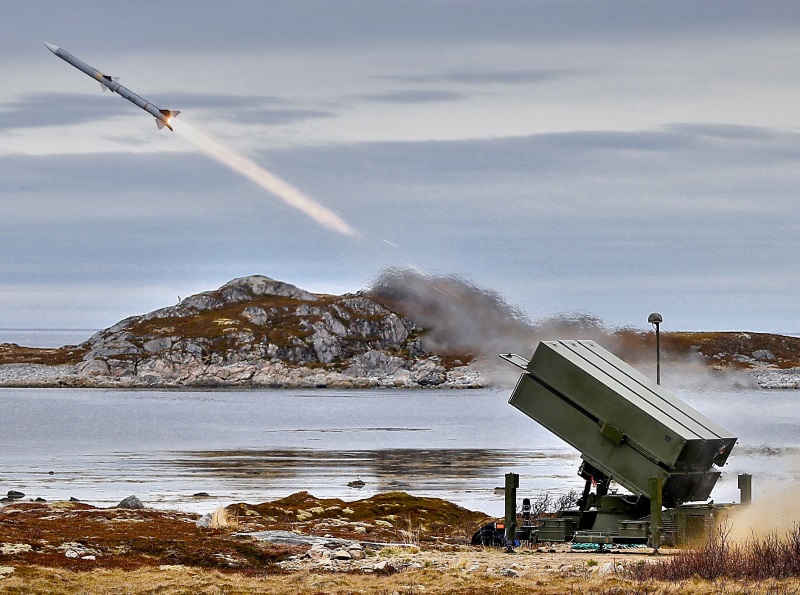
NASAMS has been exported to Chile, Finland, Lithuania, the Netherlands, Oman, Spain, and Ukraine – the Ukrainians obtaining the system in 2023 to help deal with the Russian invasion. The USA obtained NASAMS to provide air defense for the 2005 US presidential inauguration in Washington DC in 2005; it seems it is still in use there, for defense of the National Mall area. This is where the story gets complicated, since the US spent considerable effort in coming up with their own SLAMRAAM system, and came up zeroes.
From the mid-1990s, the US Army evaluated the use of AMRAAM on modified Hawk SAM trailer launchers, with eight AMRAAMs per launcher; and also on the HMMWV (High-Mobility Multipurpose Wheeled Vehicle) in a system known as "HUMRAAM" for "Hummer-AMRAAM". The HUMRAAM could handle four or six AMRAAMs on launch rails; it was eventually modified to handle four AMRAAMs and two AIM-9X Sidewinders. Photos circulate of a HUMRAAM with four AMRAAMs and two older-model Sidewinders; presumably, the Sidewinders were training dummies used as props.
The US Marines issued a development contract for such a SLAMRAAM system in 2001, which the service labeled the "Complementary Low-Altitude Weapon System (CLAWS)". The US Army issued a similar contract in 2004, just calling it "SL-AMRAAM". The Marines canceled CLAWS in 2006, with the Army killing SL-AMRAAM in 2011 -- after the expenditure of billions of dollars.
The essential problem with the programs was that the Marines and the Army did not have that much use for SLAMRAAM, and it couldn't survive budget cuts. They had the Stinger infantry-portable SAM to deal with helicopters and drones on the battlefield; SLAMRAAM was overkill for such targets, and to the extent US ground forces might be confronted with more formidable aerial threats, they could be handled by the Air Force and Navy / Marine Air. It's been a long time since the US military had to worry about control of the air.
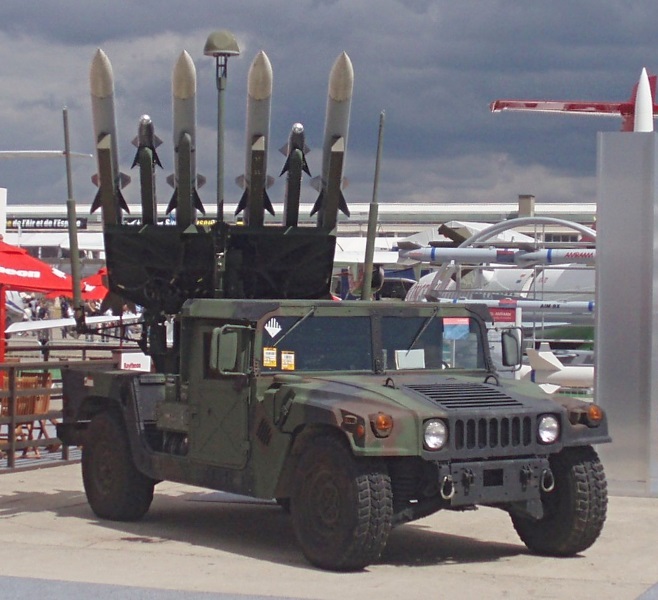
In addition, if an urgent need for SLAMRAAM did arise, the US military could acquire NASAMS -- and yes, it was acquired for air defense of Washington DC. Incidentally, HUMRAAM has been promoted as an option for NASAMs, though it is unclear if anyone has acquired it. NASAMS / SLAMRAAM is being updated to the "AMRAAM-ER", which is the RIM-162 ESSM with an AMRAAM guidance / seeker unit -- it doesn't appear that the AMRAAM-ER is precisely the same as the Block 2 ESSM. Initial flight tests were in 2021. Presumably, most NASAMS users will eventually update to the more effective AMRAAM-ER, but we'll see.
BACK_TO_TOP* The US Air Force Research Laboratory has The US Air Force Research Laboratory (AFRL) is now working on experimental programs towards the "Compact Air-to-Air Missile (CAAM)", "Extended Range Air-to-Air Missile (ERAAM)", and "Very Long Range Air-to-Air Missile (VLRAAM)".
The rationale behind CAAM is to provide a compact AAM that would allow a jet fighter to carry a large missile load -- with some sources hinting that such small AAMs could be carried by transports and other traditionally unarmed aircraft for self-defense. Details are sketchy, but the AFRL has investigated two small AAMs for CAAM, including the "Miniature Self-Defense Munition (MSDM)" and "Small Advanced Capability Missile (SACM)" programs.
Raytheon has pushed a small AAM named "Peregrine" for SACM, The company says it will have a length of 1.8 meters (6 feet) and a launch mass of about 68 kilograms (150 pounds) -- or about half the length and mass of the AMRAAM. The Peregrine will have a "multimode autonomous seeker", possibly with radar and infrared sensors, giving it "fire and forget" capability. It will have an unspecified "advanced propulsion system", and will have high end-game maneuverability.
Lockheed Martin has promoted a similar concept for SACM, named "Cuda". Peregrine and Cuda are of similar size, they have distinct differences. Lockheed Martin designed the Cuda as a "hit-to-kill" weapon, but the Peregrine carries a blast-fragmentation warhead.
Boeing has designed a two-stage AAM for ERAAM, featuring a booster stage and a "kill vehicle" second stage, with models showing the two stages to be similar in configuration. However, Boeing sees the design as modular, with options for different second stages. It's just a concept right now, however, with no hardware available.
AFRL has also conducted an investigation of advanced AAM technology under the "Missile Utility Transformation via Articulated Nose Technology (MUTANT)" program. Minimizing control surfaces to tailfins increases the range of an AAM at the expense of maneuverability; adding more control surfaces improves maneuverability at the expense of weight. MUTANT attempts to solve this quandary by using only tailfins, but having a joint between the front and rear sections of the AAM, with the front section tilting towards the target.
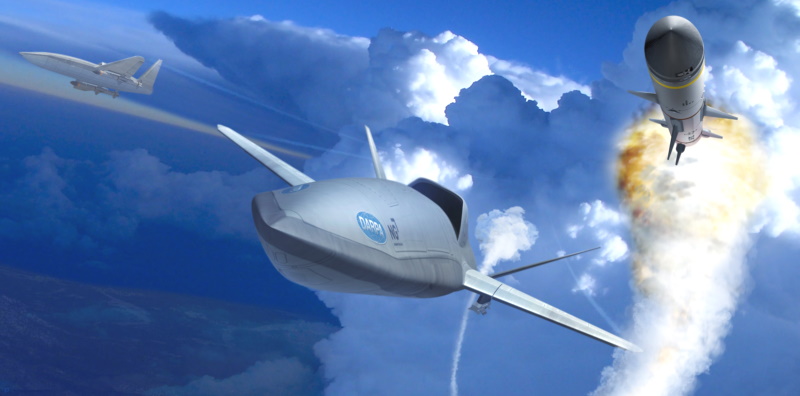
The US Defense Advanced Research Projects Agency (DARPA), the Pentagon's "blue sky" research office, is working an investigation named "Longshot", in which a fighter would engage targets at long range by launching a high-speed drone, which would carry small AAMs for terminal attack. Plans are to fly demonstration systems, to see if the idea really has any merit. None of these advanced AAM schemes are ready for production yet, and they also are hard to track; much is kept secret, and there are often changes in plans. It's certain that new AAMs will be introduced, there's just no way of knowing what will happen.
* Sources include:
There are not a lot of formal sources on munitions, so studies of them become a scavenger hunt, working from Wikipedia and other online sources, in particular industry press releases.
* Illustration credits:
* This document started life as separate documents on the Falcon / Sidewinder and the Sparrow / AMRAAM, with the two documents later merged. The revision history is as follows:
v1.0.0 / 01 apr 19 / Chapter 1 stand-alone release. v1.0.0 / 01 may 19 / Chapter 2 stand-alone release. v1.1.0 / 01 may 19 / Review & polish. v2.0.0 / 01 mar 21 / Merged 2-chapter release. v2.1.0 / 01 jul 21 / Review & polish. v2.2.0 / 01 jun 23 / Review & polish (plus tweak).BACK_TO_TOP
